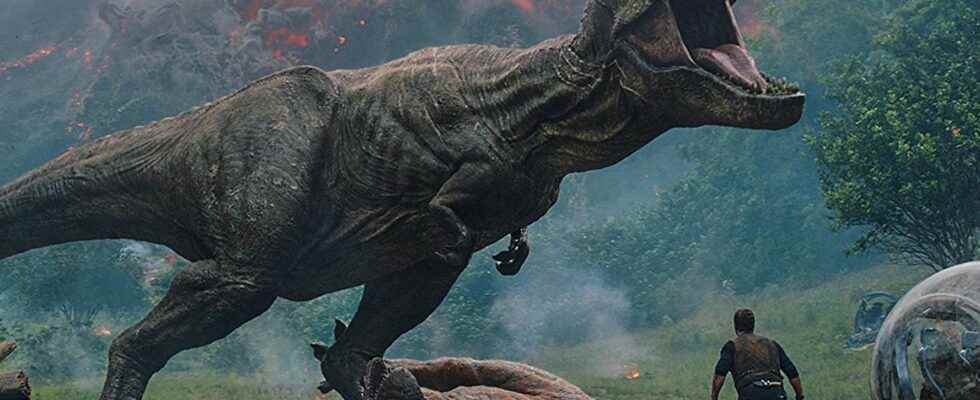From the blood of a mosquito in which there wasDNA preserved dinosaur, researchers recreate a dinosaur. Then another. And another. Until resuscitating dozens of different species of dinosaurs: 37 at the opening of the park Jurassic World. Besides the plausible aspect, or not, of this scientific prowess, should we do the same if we had the possibility?
The next installment in the saga Jurassic Park – Jurassic World came out today. © Jurassic World
No, the dinosaurs would not want to eradicate humanity
If the films of the saga suggest that the dinosaurs have only one thing in mind, to devour humans, it is not so! Various scientific studies have shown that they were, conversely, quite pacifists. In particular herbivorous dinosaurs: a study has shown that some of Canada’s megadinosaurs even had regular plants! For the others, of course, the competition was very present, but above all expressed a defense to find food and protect the young. These ancestors of our current birds were in fact social animals, as explained to Futura in a previous article paleontologist Jack Horner who inspired the character of Alan Grant in Jurassic Park.
According to him, if we were to bring them back among us, “They would be like pets. I don’t think they should be released into the wild, but rather cared for, as with dogs and cats”. Indeed, if we were to recreate dinosaurs, they would find themselves in an environment very different from their original habitat. Could they survive in such conditions? Not sure, because they would have to adapt to current climatic conditionsand to a biodiversity much more extensive than in their time. But still according to Jack Horner: “Dinosaurs would do just fine in our environment. They lived everywhere on the planet, from the equator to the poles. Herbivorous dinosaurs may have been plant-specific, but most dinosaurs had teeth that could support a wide variety of diets, like iguanas, which can eat anything and everything. » And if eventually we were to cohabit, like cohabitation with other predators, we would probably end up gaining the upper hand.
A feat imaginable in the not so near future
In 2020, Jack Horner estimated that we would have to wait until 2025 to see the first recreated dinosaurs. But is it possible to imagine a dinosaur in less than three years? Probably not. First of all, resurrecting a dinosaur requires DNA. However, it can last only 6.8 million years before being completely destroyed. Additionally, the information genetic becomes unreadable after 1.5 million years. It is therefore impossible to hope to reconstitute dinosaurs by their DNA, knowing that they died out more than 65 million years ago!
There remains the possibility of creating them from existing species: by genetic modification. For this, it is the birds that are best designated, being the successors of certain dinosaurs. This is how the project of chickenosaurus or its French equivalent chickenosaurus. The idea would be to genetically modify, in particular thanks to CRISPR-Cas9, a chicken: add teeth and an articulated tail to it, and give it three legs with three fingers instead of wings.
This project, created more than 10 years ago, has unfortunately (or fortunately) not succeeded for the moment. © TED, YouTube
Recreate recently extinct species?
Considering the duration life of DNA, even if it means trying to recreate a species, might as well aim for a more recent one. For example, tasmanian tigerssleeps, or even mammoths ! Extinct thousands of years ago according to subspecies mammoth, biologists plan to use the molecular scissors of CRISPR-Cas9, by introducing into Asian elephant DNA elements of DNA from woolly mammoth. According to start-up which launched this project, these “improved elephants” could then migrate to colder regions thanks to the characteristics conferred by mammoth DNA, and then thrive there, far from humans. Thus, it would not be an actual resurrection of the species, but rather an improvement of an existing species. Rather than genetics, many researchers plan to use the cloningwhich involves transferring somatic cells adults in eggs or eggs of a closely related species. In particular, cloning has been used to recreate deceased pets, such as cats !
Regardless of the process used, performing a de-extinction poses ethical issues and raises many questions. First, because the choice of the species to be resurrected requires scientific arguments, which are often lacking. Then, because the causes of their disappearance remain, at least for most species. To recreate them would then imply a probable new extinction. Moreover, the reintroduction of a species implies a change in theecosystem, and a potential threat to biodiversity, while many species are already in danger. Finally, the recreated specimens would, of course, be born in the laboratory and would be unable to evolve in a wild environment.
Special offer: for Father’s Day, offer the best of Science!
Your father is a great science enthusiast and unusual discoveries? And if you offer him a superb scientific exploration in paper format? Benefit from -20% on the Mag Futura (special offer: €15 instead of 19 €): 220 pages to explore 4 scientific issues that will shape our future!
Mag Futura is:
- 4 major scientific questions for 2022, from the Earth to the Moon
- 220 pages, 60 experts: no fake news, just science
- Home delivery with electronic gift card
- An independent scientific media
Interested in what you just read?
